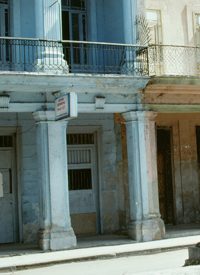
The flight of Cubans out of their horrific prison camp nation to anywhere else is a 60-year-old story. Fidel Castro inherited a nation that was among the most prosperous in the Western Hemisphere. Although there was much to dislike about Fulgencio Batista, the Cuban leader whom Castro ousted, there was also much to admire about Cuba before Castro.
Indeed, there was a great deal for collectivists to admire about Batista. Sumner Welles, Undersecretary of State under Franklin Roosevelt, actually described Batista as a communist. Batista, the first Cuban leader to bring members of the Cuban Communist Party into his Cabinet, described himself as a “progressive socialist.” When Castro attacked Batista in 1953, the Cuban Communist Party actually accused Castro of “Putchism,” another one of the surreal words invented by Marxists which onlinedictionary.com defines as “a method of revolution or overthrow involving secret planning.”
Batista had won during a competitive election in 1940, although he later effectively usurped power. Nevertheless, after his first term as President, Batista left office peacefully. Unlike Castro, who came from an affluent upper-class family, Batista grew up in poverty. He worked in the sugar cane fields, on railroads, and in the hard labor that the poor must do to survive.
Fulgencio Batista was part black, part Chinese, part American Indian, and part European. Unlike Castro, Batista genuinely was a “man of the people,” and his rise to power — from a sergeant in the Cuban army to leader of his nation — reflected that connection with ordinary people. When he was elected in 1940 with about 60 percent of the vote, he was the first non-white Cuban to win that office (the Barack Obama of his nation).
Cuba before Castro is uniformly depicted by the establishment media as horrific. The reality is dramatically different. While Batista and others ruled Cuba, the nation flourished. (This is in spite of the socialist policies of Batista, not because of those policies.) How well off was pre-Castro Cuba?
The Cuban peso had the same value as the U.S. dollar. There were 101 privately owned newspapers. Cuba had one radio per five Cubans and one television set per 28 Cubans. One out of every 40 Cubans owned a car, and one out of every 38 owned a telephone. These were among the best rates of ownership in the world. The infrastructure of Cuba — highways, ports, etc. — was considered by the U.S. Commerce Department to be the best in Latin America.
How well was labor compensated? The average Cuban industrial worker earned $6 a day in 1958. Although that figure sounds low to us in our hyper-inflated world, that wage level can be understood only in comparison with nations’ average daily industrial compensation at the time: Sweden ($8.10), Switzerland ($8.00), New Zealand ($6.72), Denmark ($6.46), and Norway ($6.10.) Cuba also had the seventh-highest level of compensation for agricultural workers in the world, behind only Canada, America, New Zealand, Australia, Sweden, and Norway. Unemployment in Cuba was the lowest in Latin America. Even the leader of the Cuban Communist Party until 1962, Anibal Escalante, said, “Cuba is one of the countries [in Latin America] in which the standard of living of the masses was particularly high.”
The per capita income was the third-highest in Latin America, after Argentina and Venezuela. Ginsburg’s 1959 Atlas of the World Economy placed Cuba at 22nd out of the 122 nations surveyed. Income surpassed that of Spain and Portugal and was comparable to that of Italy.
The Cuban public educational system received a higher percentage of the government’s budget than any other Latin American nation, with Costa Rico, a famously peaceful and orderly nation, second. Cuba also had 900 private schools and three private universities. Rural education received special attention and was supplemented by a mobile library system. According to the UN report of 1953, the literacy rate in Cuba was 82 percent, higher than in any other Latin American nation except Argentina and Costa Rica.
How healthy were Cubans before Castro? They ate quite well. Per capita consumption of meat was 65 pounds per year, exceeded only by England, Australia, and Denmark. Caloric intake was the third-highest in Latin America, after Argentina and Uruguay. The nation had the third-lowest mortality rate in the world — lower, in fact, than America or Canada. The infant mortality rate was 3.76 per thousand, while next in line in Latin America was Argentina at 6.11 and Venezuela at 6.56. In fact, the infant mortality rate in Cuba was lower than in France, Italy, Belgium, or Austria. Only Argentina had more doctors per citizen than Cuba. Life expectancy was significantly higher than in Latin America in general.
Cuba was doing well, but it was doing well in spite of the “progressive” policies of Batista, not because of Batista. What this nation needed was a return to free markets, the end of incessant government intervention on the side of labor, and public expenditures (which were often inefficient) to improve education and health. What Cuba did not need was a collectivist totalitarian such as Castro.
In the Never-Never land invented by Marxists which divides mankind into “progressives” and “reactionaries,” where was Castro? In his youth, Castro owned the complete works of Benito Mussolini. When he was tried in Cuban courts, his oral argument was virtually modeled on Hitler’s “History will absolve me” speech. When Francisco Franco died, after Castro had been in power over 15 years, Castro ordered a day of respect for the Spanish dictator.
Fidel Castro believes in power. The Cuban people have suffered grievously during the last 50 years. From 1959 to 1994, more than one million Cubans have left their island home for anywhere else. The horrors of Castro’s Gulag are as awful as anything in the ghastly history of modern totalitarianism. This nation that was once among the most affluent in the Western Hemisphere or, indeed, the world, now languishes in poverty and experiences persistent shortages of even the most basic items such as milk, soap, and clothing. Rationing is the norm.
The incidental byproducts of Castro’s Cuba are found in baseball players and other athletes who abandon their communist prison as soon as they can, in the grinding poverty of those who cannot leave, and in those desperate enough to hide in the landing gear of an airliner traveling across the Atlantic Ocean from Havana to Madrid.


